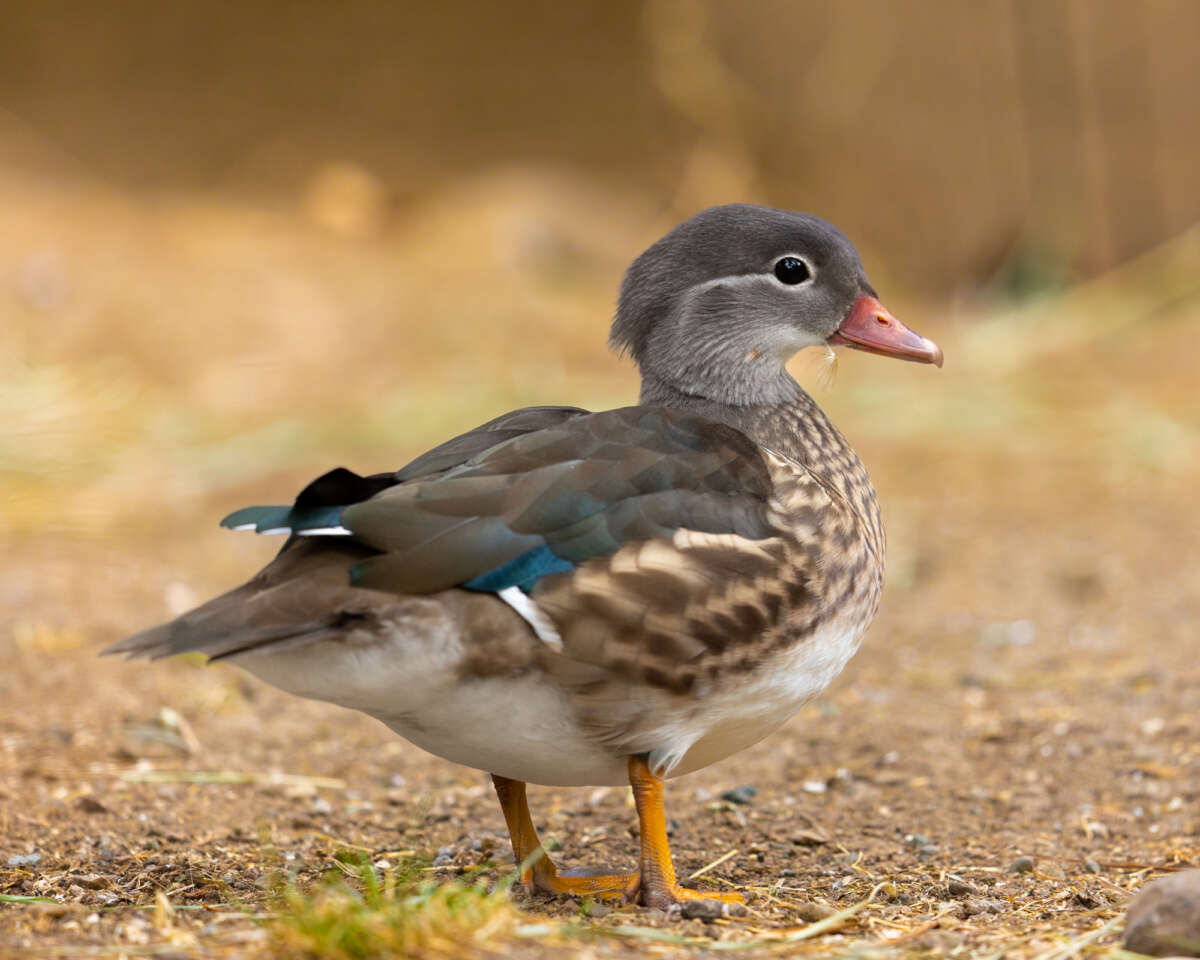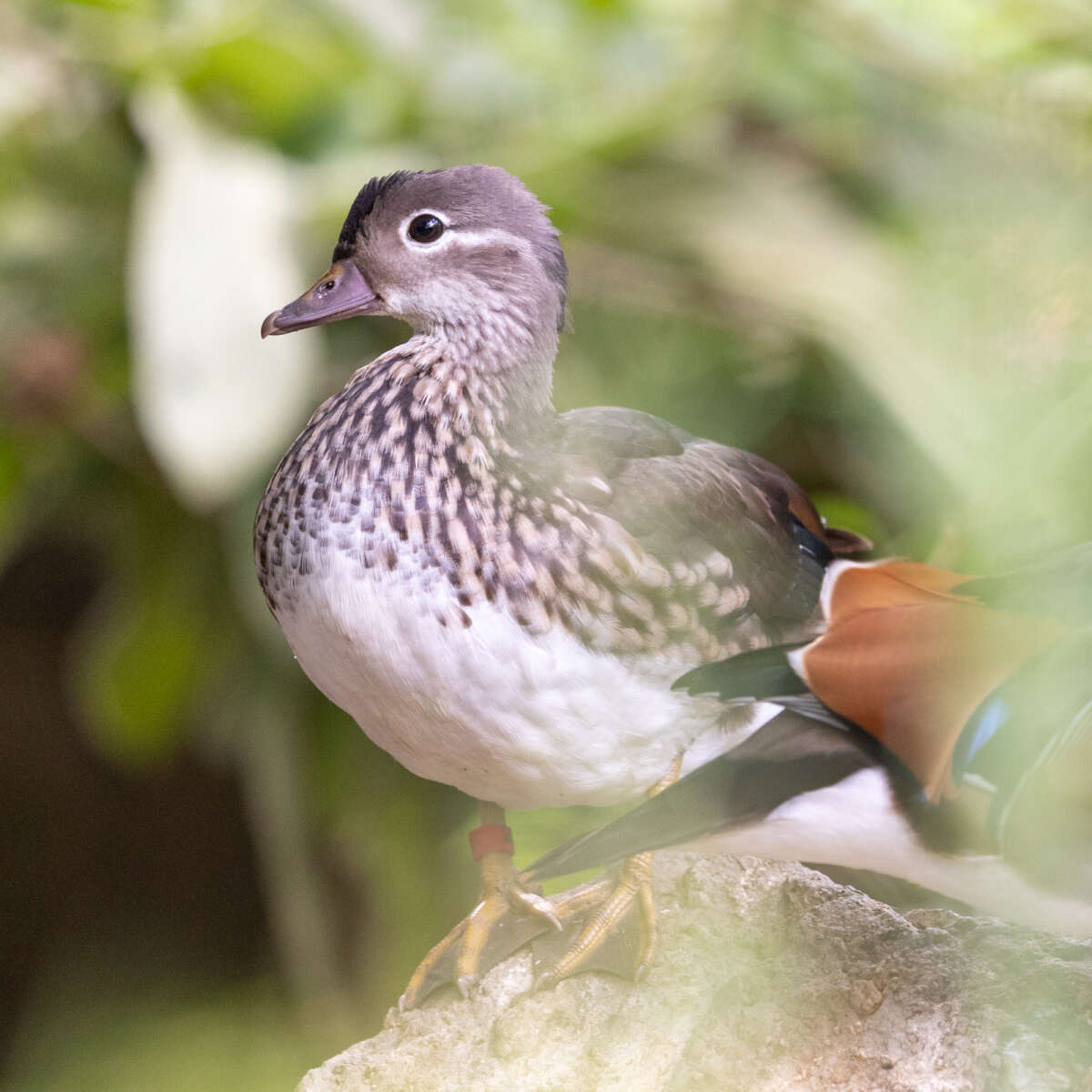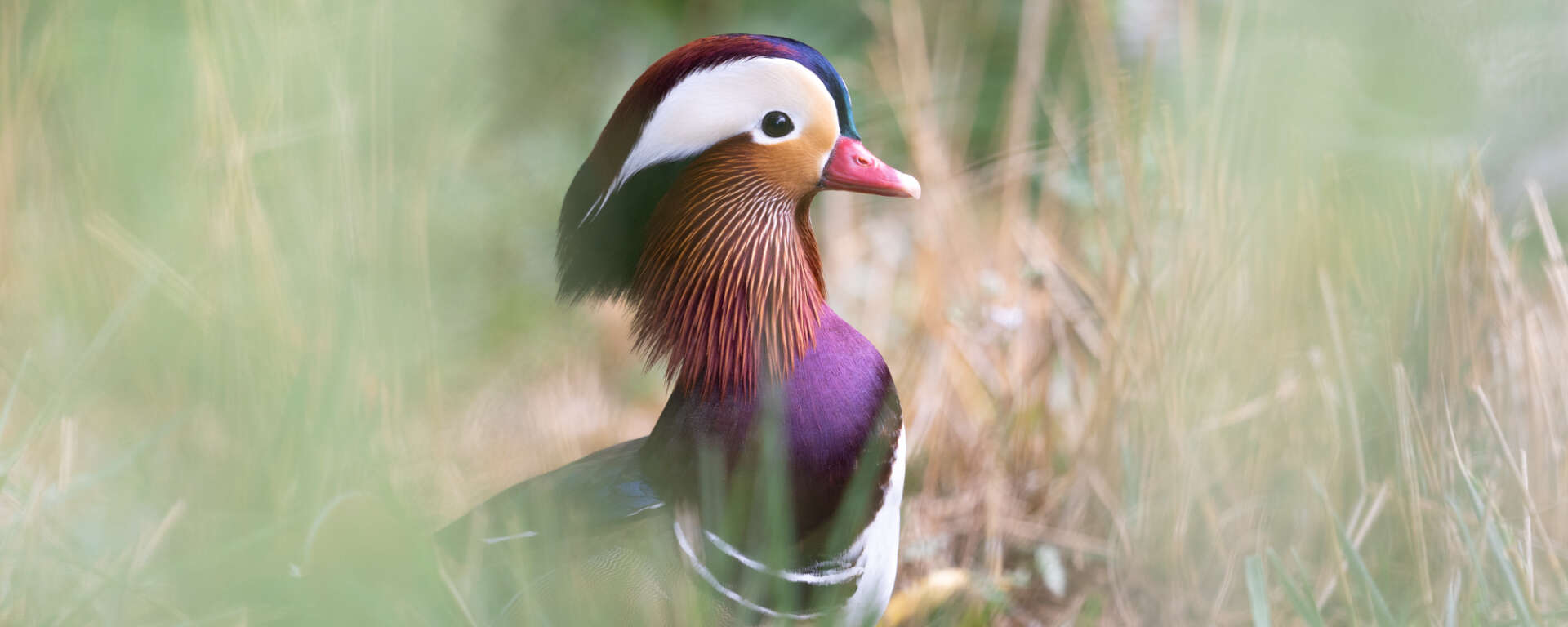Description
The male mandarin duck is unmistakable in breeding plumage, with a spectrum of color across its body. Sections of plumage are white, different shades of brown, black, and iridescent green, blue, and purple. Breeding males also have an especially distinctive brown tertial wing feather that sticks up on their back, giving the appearance of sails on a boat.
Mandarin ducks exhibit sexual dimorphism, and females are much less conspicuous than males. Females have mottled brown and white plumage across most of their bodies, as well as a distinctive thin white ring around their eye that continues back to a thin, horizontal white stripe across their cheek.
Males use their extravagant colors to attract females, while the females are able to camouflage into their woodland habitat and nesting hollows better with their more modest attire. Male mandarin ducks are more likely to attract predators with their bright plumage, so they molt their feathers twice a year and switch between two different sets of plumage: breeding plumage for the breeding season, and eclipse plumage for the rest of the year. Males in eclipse plumage look much more similar to females, but can still be distinguished by their red beaks.
Cover Photo: Male mandarin duck in breeding plumage by Mark Pressler
Classification
- Overview
- The mandarin duck is a bird in the Anseriformes, or waterfowl order. Its closest relative is the wood duck. The relationship of the genus Aix to other waterfowl within the family Anatidae is still uncertain, as biologists are unsure if the 2 Aix species, the mandarin duck and the wood duck, are more closely related to the dabbling ducks of the subfamily Anatinae, or the shelducks of the subfamily Tadorninae.
- Class
- Aves
- Order
- Anseriformes
- Family
- Anatidae
- Genus
- Aix
- Species
- A. galericulata
Key Facts
- Conservation Status
- Least Concern
- Lifespan
- ~10 years, but this is from a small sample size of banded individuals and likely underestimated. Anecdotal reports up to 20 years under human care
- Height
- 16.1 – 20.1 in (41 – 51 cm)
- Weight
- 0.98 – 1.10 lbs (444 – 500 g)
- Wingspan
- 2.1 – 2.5 ft (65 – 75 cm)
The IUCN Red List describes the mandarin duck as a species of Least Concern, meaning conservationists around the world are not currently worried about the continuation of this species. The current total population size is unknown—a 2006 report estimated 65,000 – 66,000 individuals with a decreasing trend, but at a slow enough rate and with enough stable populations to not be reclassified as Near Threatened.
Social Life
Mandarin ducks are secretive ducks, spending much of their time in densely vegetated waterways. Anecdotal reports say that these ducks typically are found in smaller flocks than many other duck species, but little else is known about their social life.
Habitat and Range
These ducks are typically found in creeks, rivers, lakes, pools, swamps, and other water bodies surrounded by dense forests.
Mandarin ducks are found natively in eastern Asia, in Japan, China, Russia, Korea, and Taiwan. There is also a large introduced population in southern Great Britain, as well as scattered populations across much of western Europe.
Diet
Mandarin ducks are omnivores. They mostly eat seeds and nuts, namely acorns, as well as some aquatic plants. They will also occasionally eat fish, insects, and snails.
Predators
These ducks have a fairly wide range, so their predators change depending on the population. Mustelids such as minks and polecats, as well as owls, otters, and raccoon dogs will all hunt the mandarin duck. Some snake species have also be observed preying on mandarin duck eggs.
Reproduction
Sexual Maturity: ~1 year
Nesting Season: April – June
Incubation: 28 – 30 days
Clutch Size: 9 – 12 eggs, larger clutches are sometimes seen due to brood parasitism
- Information
-
Description
The male mandarin duck is unmistakable in breeding plumage, with a spectrum of color across its body. Sections of plumage are white, different shades of brown, black, and iridescent green, blue, and purple. Breeding males also have an especially distinctive brown tertial wing feather that sticks up on their back, giving the appearance of sails on a boat.
Mandarin ducks exhibit sexual dimorphism, and females are much less conspicuous than males. Females have mottled brown and white plumage across most of their bodies, as well as a distinctive thin white ring around their eye that continues back to a thin, horizontal white stripe across their cheek.
Males use their extravagant colors to attract females, while the females are able to camouflage into their woodland habitat and nesting hollows better with their more modest attire. Male mandarin ducks are more likely to attract predators with their bright plumage, so they molt their feathers twice a year and switch between two different sets of plumage: breeding plumage for the breeding season, and eclipse plumage for the rest of the year. Males in eclipse plumage look much more similar to females, but can still be distinguished by their red beaks.
Cover Photo: Male mandarin duck in breeding plumage by Mark Pressler
Classification
- Overview
- The mandarin duck is a bird in the Anseriformes, or waterfowl order. Its closest relative is the wood duck. The relationship of the genus Aix to other waterfowl within the family Anatidae is still uncertain, as biologists are unsure if the 2 Aix species, the mandarin duck and the wood duck, are more closely related to the dabbling ducks of the subfamily Anatinae, or the shelducks of the subfamily Tadorninae.
- Class
- Aves
- Order
- Anseriformes
- Family
- Anatidae
- Genus
- Aix
- Species
- A. galericulata
Key Facts
- Conservation Status
- Least Concern
- Lifespan
- ~10 years, but this is from a small sample size of banded individuals and likely underestimated. Anecdotal reports up to 20 years under human care
- Height
- 16.1 – 20.1 in (41 – 51 cm)
- Weight
- 0.98 – 1.10 lbs (444 – 500 g)
- Wingspan
- 2.1 – 2.5 ft (65 – 75 cm)
- Conservation
The IUCN Red List describes the mandarin duck as a species of Least Concern, meaning conservationists around the world are not currently worried about the continuation of this species. The current total population size is unknown—a 2006 report estimated 65,000 – 66,000 individuals with a decreasing trend, but at a slow enough rate and with enough stable populations to not be reclassified as Near Threatened.
- Lifestyle
Social Life
Mandarin ducks are secretive ducks, spending much of their time in densely vegetated waterways. Anecdotal reports say that these ducks typically are found in smaller flocks than many other duck species, but little else is known about their social life.Habitat and Range
These ducks are typically found in creeks, rivers, lakes, pools, swamps, and other water bodies surrounded by dense forests.Mandarin ducks are found natively in eastern Asia, in Japan, China, Russia, Korea, and Taiwan. There is also a large introduced population in southern Great Britain, as well as scattered populations across much of western Europe.
Diet
Mandarin ducks are omnivores. They mostly eat seeds and nuts, namely acorns, as well as some aquatic plants. They will also occasionally eat fish, insects, and snails.Predators
These ducks have a fairly wide range, so their predators change depending on the population. Mustelids such as minks and polecats, as well as owls, otters, and raccoon dogs will all hunt the mandarin duck. Some snake species have also be observed preying on mandarin duck eggs.Reproduction
Sexual Maturity: ~1 year
Nesting Season: April – June
Incubation: 28 – 30 days
Clutch Size: 9 – 12 eggs, larger clutches are sometimes seen due to brood parasitism

Adult male mandarin duck in eclipse plumage by Mark Pressler

Adult female mandarin duck by Mark Pressler

